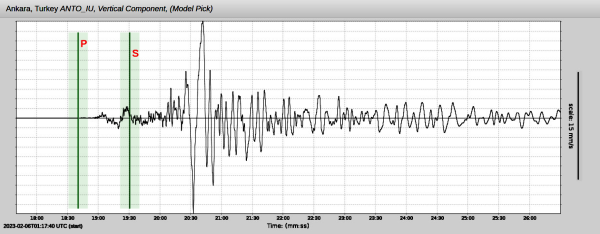In this USB-C series, we’ve covered quite a bit of USB-C – things that are well known, things that should be better known, and a couple things that just appeared online for the first time. We’ve covered almost everything in some depth except USB Power Delivery. I’ve described the process a bit in the “Power” article, but that was mostly about how to use PD by simply buying the right solution. However, that’s not enough for a hacker. Let’s see if we can make our own PD trigger board. Continue reading “All About USB-C: Talking Low-Level PD”
Interest978 Articles
Ask Hackaday: Incidental Earthquake Detection
It never seems to fail: at the very moment that human society seems to reach a new pinnacle of pettiness, selfishness, violence, and self-absorption, Mother Nature comes along and reminds us all who’s really in charge. The obvious case in point here is the massive earthquakes near the border of Turkey and Syria, the appalling loss of life from which is only now becoming evident, and will certainly climb as survivors trapped since the Monday quakes start to succumb to cold and starvation.
Whatever power over nature we think we can wield pales by comparison with the energy released in this quake alone, which was something like 32 petajoules. How much destruction such a release causes depends on many factors, including the type of quake and its depth, plus the soil conditions at the epicenter. But whatever the local effects on the surface, quakes like these have a tendency to set the entire planet ringing like a bell, with seismic waves transmitted across the world that set the needles of professionally maintained seismometers wiggling.
For as valuable as these seismic networks are, though, there’s a looser, ad hoc network of detection instruments that are capable of picking up quakes as large as these from half a planet away. Some are specifically built to detect Earth changes, while some are instruments that only incidentally respond to the shockwaves traveling through the planet. And we want to know if this quake showed up in the data from anyone’s instruments.
Continue reading “Ask Hackaday: Incidental Earthquake Detection”
Keebin’ With Kristina: The One With The Breadboard Macropad
 For their first custom, hand-wired keyboard, [terryorchard] aka [70rch] didn’t want to mess with making a total split, and we don’t really blame them. However, as you can see, they ended up with a monoblock split, which aside from being our own personal preference, looks fantastic, and also happened to be what fit on the print bed.
For their first custom, hand-wired keyboard, [terryorchard] aka [70rch] didn’t want to mess with making a total split, and we don’t really blame them. However, as you can see, they ended up with a monoblock split, which aside from being our own personal preference, looks fantastic, and also happened to be what fit on the print bed.
What you’re looking at is a 40% remix of the Alice layout with a columnar stagger. It’s also a bit 6×3 Corne-inspired on the ergonomic front. Brain-wise, it’s got an exposed Elite Pi driving a matrix of Kailh Choc pinks and an EC11 encoder. The encoder scrolls by default, and then becomes a volume knob on the numbers and symbols layer. One super cool thing about this keyboard is the secret third layer, which is unlocked by pressing the rotary encoder. This leads to some home row mods and disables the outside columns, culminating in a test 3×5 with two layers.
Via KBD #112
Continue reading “Keebin’ With Kristina: The One With The Breadboard Macropad”
All About USB-C: Manufacturer Sins
People experience a variety of problems with USB-C. I’ve asked people online about their negative experiences with USB-C, and got a wide variety of responses, both on Twitter and on Mastodon. In addition to that, communities like r/UsbCHardware keep a lore of things that make some people’s experience with USB-C subpar.
In engineering and hacking, there’s unspoken things we used to quietly consider as unviable. Having bidirectional power and high-speed data on a single port with thousands of peripherals, using nothing but a single data pin – if you’ve ever looked at a schematic for a proprietary docking connector attempting such a feat, you know that you’d find horrors beyond comprehension. For instance, MicroUSB’s ID pin quickly grew into a trove of incompatible resistor values for anything beyond “power or be powered”. Laptop makers had to routinely resort to resistor and one-wire schemes to make sure their chargers aren’t overloaded by a laptop assuming more juice than the charger can give, which introduced a ton of failure modes on its own.
When USB-C was being designed, the group looked through chargers, OTG adapters, display outputs, docking stations, docking stations with charging functions, and display outputs, and united them into a specification that can account for basically everything – over a single cable. What could go wrong?
Of course, device manufacturers found a number of ways to take everything that USB-C provides, and wipe the floor with it. Some of the USB-C sins are noticeable trends. Most of them, I’ve found, are manufacturers’ faults, whether by inattention or by malice; things like cable labelling are squarely in the USB-C standard domain, and there’s plenty of random wear and tear failures.
I don’t know if the USB-C standard could’ve been simpler. I can tell for sure that plenty of mistakes are due to device and cable manufacturers not paying attention. Let’s go through the notorious sins of USB-C, and see what we can learn. Continue reading “All About USB-C: Manufacturer Sins”
Ask Hackaday: The Ten Dollar Digital Mixing Desk?
There comes a point in every engineer’s life at which they need a mixing desk, and for me that point is now. But the marketplace for a cheap small mixer just ain’t what it used to be. Where once there were bedroom musicians with a four-track cassette recorder if they were lucky, now everything’s on the computer. Lay down as many tracks as you like, edit and post-process them digitally without much need for a physical mixer, isn’t it great to be living in the future!
This means that those bedroom musicians no longer need cheap mixers, so the models I was looking for have disappeared. In their place are models aimed at podcasters and DJs. If I want a bunch of silly digital effects or a two-channel desk with a crossfader I can fill my boots, but for a conventional mixer I have to look somewhat upmarket. Around the three figure mark are several models, but I am both a cheapskate and an engineer. Surely I can come up with an alternative. Continue reading “Ask Hackaday: The Ten Dollar Digital Mixing Desk?”
Smart Ovens Are Doing Dumb Checks For Internet Connectivity
If you’ve ever worked in IT support, you’ll be familiar with users calling in to check if the Internet is up every few hours or so. Often a quick refresh of the browser is enough to see if a machine is actually online. Alternatively, a simple ping or browsing to a known-working website will tell you what you need to know. The one I use is koi.com, incidentally.
When it comes to engineers coding firmware for smart devices, you would assume they have more straightforward and rigorous ways of determining connectivity. In the case of certain smart ovens, it turns out they’re making the same dumb checks as everyone else.
Continue reading “Smart Ovens Are Doing Dumb Checks For Internet Connectivity”
What Losing Everything Taught Me About Backing Up
Backing up. It’s such a simple thing on paper – making a copy of important files and putting them in a safe place. In reality, for many of us, it’s just another thing on that list of things we really ought to be doing but never quite get around to.
I was firmly in that boat. Then, when disaster struck, I predictably lost greatly. Here’s my story on what I lost, what I managed to hang on to, and how I’d recommend you approach backups starting today.
Continue reading “What Losing Everything Taught Me About Backing Up”
















